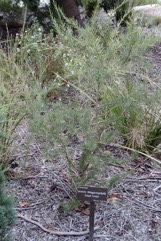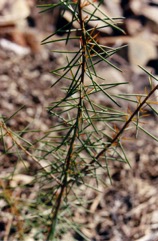Dead Finish, Kurara

A native of inland Australia. It will grow on most soils, but is most common on sandy soils near water courses. It prefers an open sunny position. It is drought and frost resistant. It suits arid and semi arid places. It mostly grows south of 21°S latitude. In its area of growth the rainfall is often only 18-25 mm per year. The temperature in the hottest month may be around 24°C. It cannot tolerate fire. It can grow in arid places.
Also known as:
Alkitjirra, Curara, Jilkuru, Kurara, Wakalpuka
Edible Portion
- Seeds, Grubs
Where does Dead Finish grow?
Found in: Australia
Notes: There are about 1,350 Acacia species. Over 1,000 occur in Australia. Also as Mimosaceae.
Growing Dead Finish, Kurara
Cultivation: It is grown from seed. The seed need treatment to break the hard seed coat. Normally this is by putting the seeds in very hot water and letting the water cool down overnight then planting the seeds immediately. It can also be grown by cuttings.
Edible Uses: The seeds are eaten raw. In some places the seeds are cooked in the pod. They are also eaten when mature after being crushed into flour. They are eaten uncooked. They have a nutty flavour. The tree also often has edible grubs in its roots.
Production: It is slow growing. Flowering is from June to December. Seed is produce in autumn.
Nutrition Info
per 100g edible portion| Edible Part | Energy (kcal) | Protein (g) | Iron (mg) | Vitamin A (ug) | Vitamin c (mg) | Zinc (mg) | % Water |
|---|---|---|---|---|---|---|---|
| Seed | 462 | 17.5 | 28.1 | - | - | 3.6 | 5.4 |
Dead Finish, Kurara Photos


References
Bindon, P., 1996, Useful Bush Plants. Western Australian Museum. p 28
Bodkin, F., 1991, Encyclopedia Botanica. Cornstalk publishing, p 35
Boomsma, C.D., 1972, Native Tree of South Australia. Woods & Forests Department South Australia, Bulletin No.19. p 49
Cancilla, D., 2018, Ethnobotanical and Ethnozoological Values Desktop Assessment - Eliwana Project. p 9
Cherikoff V. & Isaacs, J., The Bush Food Handbook. How to gather, grow, process and cook Australian Wild Foods. Ti Tree Press, Australia p 42, 188 p 47 (As Acacia genistoides)
Elliot, W.R., & Jones, D.L., 1982, Encyclopedia of Australian Plants suitable for cultivation. Vol 2. Lothian. p 122
Fragm. 4:3. 1863
Hall, N. et al, 1972, The Use of Trees and Shrubs in the Dry Country of Australia, AGPS, Canberra. p 353
Hunter, J. T. et al, Budjiti traditional use of plants on Naree Station. p 12
Hunter, J.T., 2017, Is there a relationship between contemporary high Aboriginal plant resource locations and mapped vegetation communities? Cunninghamia 17:27-34. The Royal Botanic Garden Sydney. ISSN 2200 - 405X
Lang, P. J., et al, 1986, Anangu Pitjantjatjara Lands Biological Survey. p 41
Latz, P., 1996, Bushfires and Bushtucker. IAD. p 119
Lazarides, M. & Hince, B., 1993, Handbook of Economic Plants of Australia, CSIRO. p 7
Lister, P.R., P. Holford, T. Haigh, and D.A. Morrison, 1996, Acacia in Australia: Ethnobotany and potential food crop. p. 228-236. In: J. Janick (ed.), Progress in new crops. ASHS Press, Alexandria, VA.
Paczkowska, G . & Chapman, A.R., 2000, The Western Australian Flora. A Descriptive Catalogue. Western Australian Herbarium. p 327
Pennock, A., et al, Australian Dry-zone Acacias for Human Food: Proceedings of a Workshop.